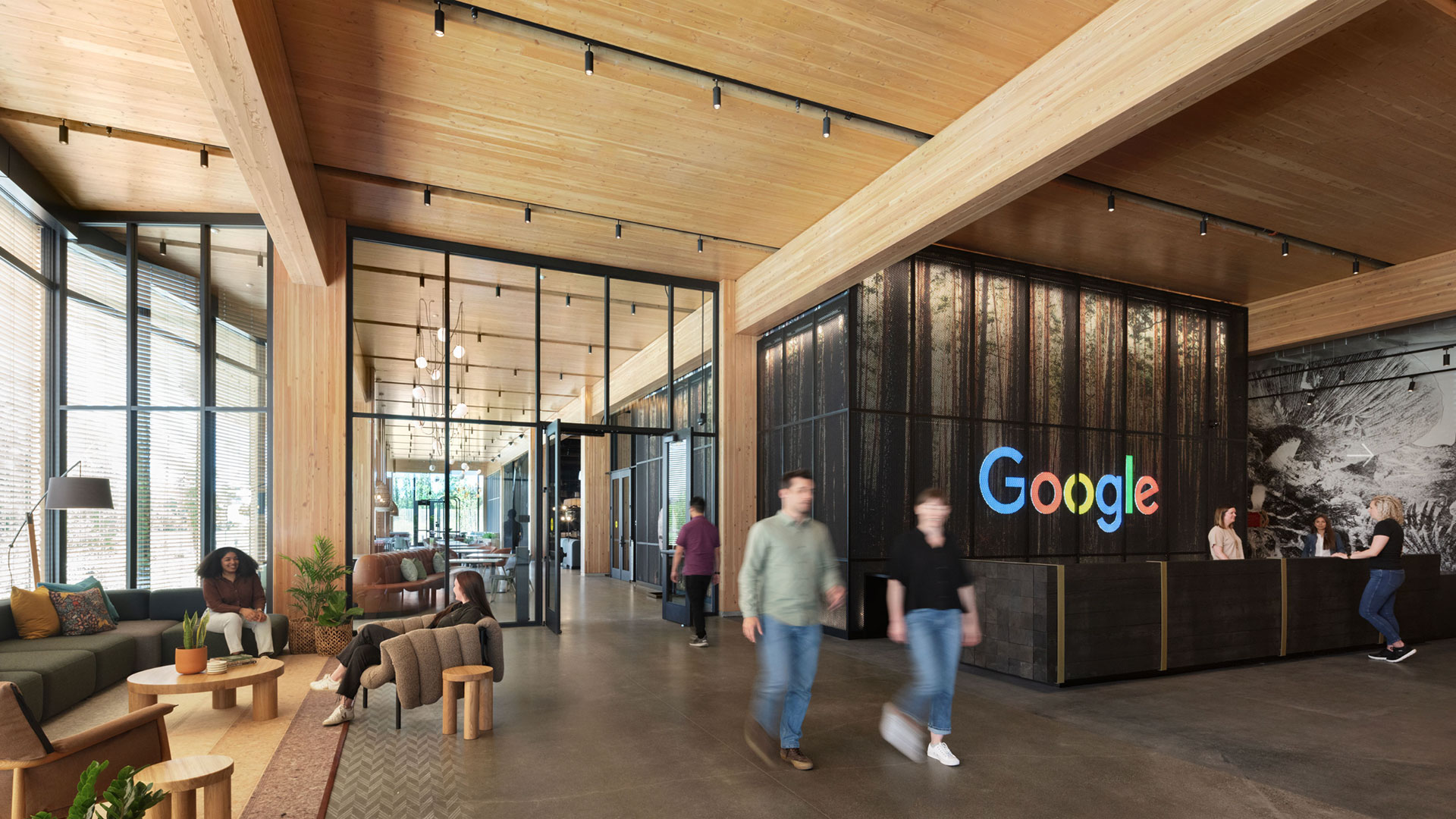
- 위치 : Sunnyvale, California
- 면적 / 층수 : 182,500 sq.ft. / 5
- 상태 : 2023년 완공
- 발주처 : Google
- 설계사 : Michael Green Architecture
- 구조 엔지니어 : Equilibrium
- 시공사 : XL Construction
- 제품 : Douglas Fir (DF)
- 총량 : 5,100 m³
- CLT(교차 적층 목재): 3,100 m³
- 글루램(집성재): 2,000 m³
구글 1265 보레가스(Google 1265 Borregas)는 5층 규모, 약 182,500제곱피트(약 16,950㎡)의 사무용 건물로, 지속가능한 디자인의 새로운 기준을 제시합니다. 이 건물은 구글의 최초의 ‘지상에서부터 전면적으로 건축된 대형 집성목(Mass Timber) 개발 프로젝트로, 환경 친화적 건축의 새로운 벤치마크를 세웠습니다. 첨단의 바이오필릭(자연 친화적) 설계 원칙, 진보된 구조 및 시공 기술, 그리고 지속가능한 자재를 결합하여 혁신적이면서도 영감을 주는 업무 공간을 구현했습니다.
LEED 플래티넘(Platinum) 인증을 받은 이 건물은 집성목(Mass Timber)을 사용해 탄소 배출을 크게 줄이는 동시에 따뜻하고 환영받는 분위기를 조성합니다. 설계는 단층 및 복층의 천장 높이 공간으로 구성되어 있으며, 4층 높이의 중앙 아트리움이 이들을 유기적으로 연결합니다. 글루램(glulam, 집성 목재) 채광창을 통해 자연광이 풍부하게 들어와 사람들 간의 시각적·물리적 연결감을 형성합니다. 프로젝트에는 **더글라스 전나무(Douglas Fir) 3중, 7중, 9중 합판(총 3,100㎥)과 글루램 거더, 퍼린, 기둥(총 2,000㎥)이 사용되어, 집성목의 다양성과 아름다움을 보여줍니다.
외관의 특징으로는 14피트(약 4.3m) 길이의 캔틸레버(돌출형) 플로어 플레이트가 있어, 야외 좌석 공간을 제공하고 실내로 더 많은 자연광이 들어오게 합니다. 이러한 돌출 구조는 CLT(교차 집성목) 패널과 콘크리트 보 및 슬래브를 결합한 목재-콘크리트 복합 시스템을 통해 구현되었습니다. 이 시스템은 스팬(지지 간격)과 하중 용량을 최적화하면서도 보의 깊이를 최소화했습니다.
하이브리드 구조 설계를 통해 지진 저항성을 확보했으며, CLT 바닥 패널은 수평 다이아프램 역할을 하고, 버클링 억제 강철 브레이스 프레임(BRBF)이 집성목 중력 시스템에 통합되었습니다. 목재와 강철을 조화롭게 결합함으로써 심미적 균형감을 더했을 뿐 아니라, 추가적인 내화 처리 없이도 노출형 강철 프레임을 구현할 수 있었습니다. 디자인 전반에서 바이오필릭 요소가 중심이 됩니다. 자연 소재, 풍부한 일광, 유기적 질감은 단순한 미적 요소가 아니라, 직원들의 웰빙과 협업을 촉진하기 위한 의도적인 설계입니다. 이는 구글의 혁신적인 기업 문화와도 완벽하게 부합합니다. 구글 1265 보레가스는 단순히 탄소 발자국을 줄이는 것을 넘어, 현대 건축이 나아갈 지속가능한 새로운 방향을 제시하고 있습니다.
이 프로젝트는 구글이 2030년까지 ‘탄소 제로 운영’을 달성하겠다는 더 큰 목표의 일환으로, 사람 중심의 디자인을 유지하면서도 지속 가능한 솔루션을 확장할 수 있다는 강력한 사례로 평가받고 있습니다.
- Location : Sunnyvale, California
- Size / Stories : 182,500 sq.ft. / 5
- Status : Completed 2023
- Owner : Google
- Architect : Michael Green Architecture
- Structural Engineer : Equilibrium
- General Contractor : XL Construction
- Products : Douglas Fir (DF)
- Product Volume : 5,100 m³
- CLT : 3,100 m³
- Glulam : 2,000 m³
Google 1265 Borregas is a five-story, 182,500-square-foot office building that redefines sustainable design. As Google’s first ground-up mass timber development, it sets a new benchmark for environmentally conscious architecture. The building blends cutting-edge biophilic principles, advanced structural and construction techniques, and sustainable materials to deliver a workspace that’s as inspiring as it is innovative.
Certified LEED Platinum, the building uses mass timber to slash carbon emissions while creating a warm, welcoming environment. Its design features soaring single- and double-height spaces, all tied together by a stunning four-story atrium. Natural light streams through a glulam skylight, connecting people visually and physically across the space. The project incorporates Douglas Fir 3-, 7-, and 9-ply panels (3,100 m³) and glulam girders, purlins, and columns (2,000 m³), showcasing the versatility and beauty of mass timber.
Exterior highlights include expansive 14-foot cantilevered floor plates, offering sheltered outdoor seating and increased natural light indoors. These cantilevers were made possible by a wood-concrete composite system that connects CLT panels with concrete beams and slabs, optimizing span and load capacities while minimizing beam depth.
A hybrid structural design ensures the building’s seismic resilience, with CLT floor panels serving as a horizontal diaphragm and buckling-restrained steel braced frames integrated into the mass timber gravity system. By blending the mix of materials in both mass timber and steel provided a complementary aesthetic look. Also, this approach allows for exposed steel frames without additional fireproofing. Throughout the design, biophilic elements take center stage. Natural materials, abundant daylight, and organic textures are more than aesthetic choices—they’re intentional features aimed at boosting wellness and fostering collaboration, aligning perfectly with Google’s innovative culture. By embracing mass timber, 1265 Borregas isn’t just reducing its carbon footprint—it’s setting a new standard for what’s possible in modern construction.
As part of Google’s larger commitment to carbon-free operations by 2030, this project is a powerful example of how thoughtful design can scale sustainable solutions while keeping people at the heart of the process.


